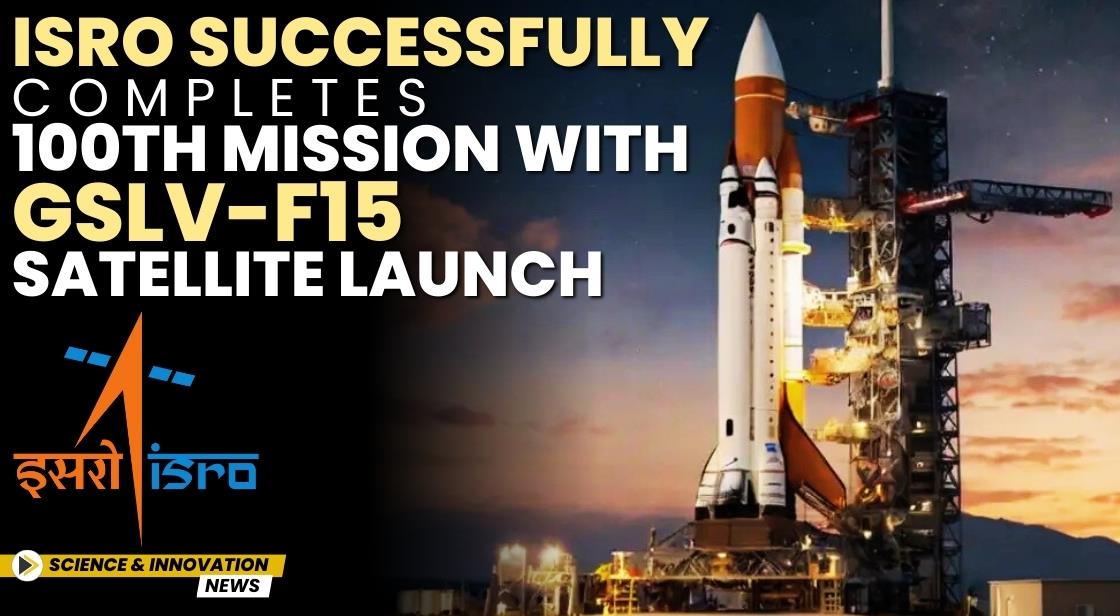ISRO Successfully Completes 100th Mission with GSLV-F15 Satellite Launch

News Synopsis
India’s premier space agency, the Indian Space Research Organisation (ISRO), achieved a major landmark on Wednesday morning by successfully launching its 100th space mission.
The Geosynchronous Satellite Launch Vehicle (GSLV-F15) lifted off at 6:23 a.m. from the Sriharikota spaceport in Andhra Pradesh, carrying the NVS-02 navigation satellite into orbit.
ISRO confirmed the success of the mission through an announcement on X, stating:
“LIFTOFF! The GSLV-F15 has successfully taken flight, carrying NVS-02 into its planned orbit. Stay tuned for more mission updates!”
This landmark mission reinforces India’s position as a global space leader and showcases its advancements in satellite navigation technology.
India's Leadership in Space: A Landmark Moment for ISRO
Union Minister of State for Science and Technology, Dr. Jitendra Singh, hailed the achievement, calling it a “historic moment” for India's space program. He congratulated ISRO on achieving this milestone, emphasizing how far India has come in its space journey.
In a post on X, Dr. Singh wrote:
“It’s a privilege to be associated with the Department of Space at the historic moment of this record feat.”
Reflecting on ISRO’s remarkable progress, he added:
“From a humble beginning by Vikram Sarabhai, Satish Dhawan, and a few others, it has been an amazing journey. And a quantum leap after PM @narendramodi ‘unlocked’ the Space sector and instilled the confidence that ‘sky is Not the limit’.”
The statement underscores the rapid advancements Indian Space Research Organisation (ISRO) has made, particularly after the Indian government opened the space sector to private players and provided increased funding and autonomy to drive innovation.
Mission Overview: Key Highlights of the GSLV-F15 Flight
-
17th GSLV Mission: This launch marks the 17th flight of the Geosynchronous Satellite Launch Vehicle (GSLV).
-
11th Success with Indigenous Cryogenic Technology: It is the 11th successful flight using an indigenous cryogenic stage.
-
8th Operational Flight with Cryogenic Propulsion: This mission further cements ISRO’s capabilities in cryogenic technology, essential for high-payload space missions.
What is the NVS-02 Navigation Satellite?
The NVS-02 satellite is a significant addition to India’s Navigation with Indian Constellation (NavIC) system. Designed to provide precise Position, Velocity, and Timing (PVT) services, it enhances India’s Regional Navigation Satellite System (RNSS) by expanding its operational satellites from four to five, ensuring better service reliability and performance.
Key Features of NVS-02:
-
Mass & Power: Weighs 2,250 kg with a power handling capability of 3 kW
-
Navigation Payloads: Operates on L1, L5, and S bands, ensuring robust navigation services
-
C-Band Ranging Payload: Enables accurate positioning and navigation
-
Geostationary Position: Located at 111.75° E, replacing the IRNSS-1E satellite
ISRO described the mission’s technical details in an official statement, stating:
“The NVS-02 satellite is the second generation of NavIC satellites, featuring a standard I-2K bus platform. It will have a lift-off mass of 2,250 kg, power handling capability of around 3 kW, navigation payload in L1, L5, and S bands, ranging payload in C-band, and will be positioned at 111.75 degrees E, replacing IRNSS-1E.”
How NavIC Strengthens India’s Satellite Navigation System
India’s NavIC system, often considered India’s alternative to GPS, provides two primary services:
1. Standard Positioning Service (SPS):
-
Available for civilian users
-
Offers position accuracy better than 20 meters
-
Ensures timing accuracy under 40 nanoseconds
2. Restricted Service (RS):
-
Used by government and defense agencies
-
Encrypted for strategic applications
NavIC enhances India's self-reliance in satellite navigation, reducing dependence on foreign GPS systems. It is particularly useful for sectors like transportation, disaster management, and geospatial applications.
Conclusion: Strengthening India’s Space Legacy
ISRO’s 100th mission is a defining milestone in India’s space exploration journey. With the successful launch of GSLV-F15 and the deployment of NVS-02, ISRO continues to push the boundaries of satellite navigation and regional connectivity. The enhanced NavIC system is set to offer more reliable, precise, and efficient navigation services, reinforcing India's position as a global leader in space technology.
With continued investments and innovation, ISRO is expected to play a crucial role in future space missions, including interplanetary explorations and satellite-based communication advancements.
You May Like









